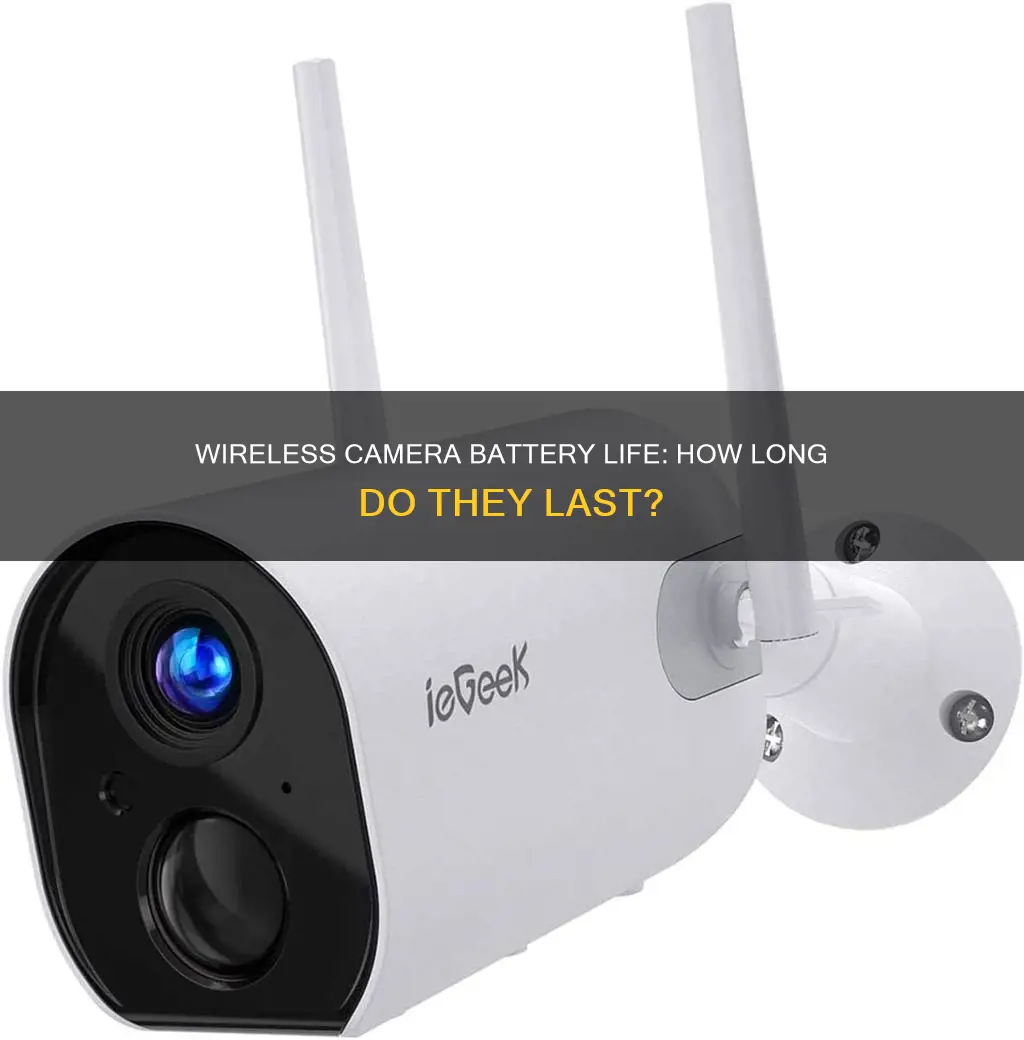
Wireless security cameras are a popular choice for home security due to their convenience and ease of installation. However, one of the biggest concerns for homeowners is the battery life of these devices. The length of time that batteries last in wireless cameras depends on various factors, including usage, battery type, temperature, and settings. On average, a wireless security camera battery will last between one and six months, but this can vary from one month to over three years.
| Characteristics | Values |
|---|---|
| Battery life range | 1 month to 3 years |
| Factors affecting battery life | Usage of the camera, type of battery, signal strength, temperature, firmware, placement, motion detection, internet connection, night vision technology, etc. |
| Recharge time | 2-10 hours |
| Lifespan of batteries | At least 5 years |
| Average charging time per day | 5 minutes |
What You'll Learn

Motion-activated cameras
In addition to motion activation, there are other features that can help extend battery life. For example, some cameras have energy-saving modes that reduce motion detection sensitivity or only detect people, ignoring non-human movement.
The type of battery also makes a difference. Lithium-ion batteries can be charged between 300 and 500 times, while nickel-metal hydride power cells can last up to 1000 charges.
To further maximise battery life, it is recommended to monitor the health of your battery-operated cameras. This can be done through a service provided by security companies, such as Pro-Vigil, to ensure the cameras are functioning properly and to catch any issues before they become problems.
By combining motion-activated cameras with energy-saving features and the right type of battery, you can extend the life of your wireless camera batteries and ensure your security system is always operational when you need it.
Charging Your SLS Camera: A Step-by-Step Guide
You may want to see also

Cold weather and battery life
Cold weather can have a significant impact on battery life, and this is true for wireless camera batteries, too. The performance of a battery is largely dependent on its temperature, and this is especially true in freezing temperatures.
In cold weather, chemical reactions within the battery slow down, reducing the amount of current the battery can produce. This means that a cold battery will drain faster than a battery at room temperature. In fact, at very low temperatures, a battery's performance can be reduced by as much as 50%. For example, at minus-4 degrees Fahrenheit, a battery's performance is halved.
The colder it gets, the more power a battery needs to start up. This is true of car batteries, for instance, which are put under severe stress in cold weather. This is because the oil thickens, internal components are strained, and the radiator, belts and hoses slow down the engine. This means that the battery has to work harder to get the engine going.
To combat this, it's a good idea to keep batteries warm just before use. For instance, keeping smaller batteries in a pocket can help. For car batteries, parking in a garage can help to keep the vehicle protected from the cold.
However, it's worth noting that the effect of temperature on a battery depends on its design and chemistry. If the current drawn by the equipment is low in relation to the power rating of the cell, then the temperature may have a negligible effect.
Additionally, while cold batteries discharge faster, unused batteries will actually lose their charge more slowly at cooler temperatures. So, while cold temperatures can reduce the performance of a battery, they can also help to preserve unused batteries.
Charging Your Canon Camera Battery via USB: How Long?
You may want to see also

Battery capacity
Wireless security cameras typically use one of two types of batteries: rechargeable lithium-ion batteries and replaceable alkaline batteries. Rechargeable lithium-ion batteries are the most common option and can be recharged using a camera power adapter or a small solar panel. These batteries generally last for about two to three years and can provide power for around 24-48 hours once fully charged. However, the actual runtime depends on the battery capacity and the camera's power consumption. On the other hand, replaceable alkaline batteries have a shorter lifespan, typically lasting from a few weeks to a few months, depending on their quality.
The runtime of wireless security cameras can be influenced by various factors, including camera usage, security camera settings, temperature, firmware, and signal strength. Cameras in high-traffic areas or locations with frequent motion will deplete their batteries more quickly. Additionally, continuous video recording, night vision technology, and outdated firmware can contribute to faster battery drainage.
To optimise battery life, it is recommended to use motion-activated cameras, adjust motion detection sensitivity, utilise battery-saving modes, and ensure proper lighting conditions. By considering these factors and implementing energy-saving measures, users can extend the battery life of their wireless security cameras.
Charging Your Spy Pen Camera: A Quick Guide
You may want to see also

Signal strength
To maximize battery life, it is essential to ensure a strong and stable signal. This can be achieved by maintaining a reasonable distance between the camera and the connecting hub, such as keeping the camera within range of the Wi-Fi router. Obstructions such as walls, ceilings, and metal can interfere with the signal, so it is important to minimize or eliminate them.
Additionally, the location of the camera plays a vital role in signal strength. If the camera is in a remote or inaccessible location, it may be necessary to consider alternative power sources, such as solar power, to extend the life of the battery.
Another factor to consider is the stability of the wireless internet connection. A weak or unstable connection can cause the camera battery to drain faster as it compensates for the poor signal. Regular firmware updates for both the camera and the wireless router can help ensure optimum signal stability, functionality, and strength.
By optimizing signal strength through strategic camera placement, reducing obstructions, and maintaining a stable wireless connection, users can significantly improve battery life in wireless security cameras.
Best Doorbell Cameras Without Monthly Fees
You may want to see also

Firmware upgrades
Firmware is the software installed internally in your camera that controls the hardware itself. It is essentially the "operating system" of the device. Just like the operating systems on your computer, firmware needs to be updated from time to time to work properly and ensure your camera is reliable and has the latest features and fixes.
How to Upgrade Your Camera's Firmware:
The process of updating camera firmware is quite similar across brands, although there are some brand-specific differences. Here is a general step-by-step guide:
- Identify the Camera's Current Firmware Version: Before updating, find out if an update is necessary by comparing the firmware version on your camera with the latest version available from the manufacturer. This information can be found in your camera's settings under "Firmware Version" or something similar.
- Compare Your Firmware Version to the Latest Version: Visit the manufacturer's website and navigate to the support section, where you will find information about the latest software updates and instructions on how to apply them. Compare the listed firmware version with the one on your camera.
- Download the Firmware Update to Your Computer: If your camera does not have the latest update, download the install file from the manufacturer's website. The file format will depend on your computer's operating system (e.g., .exe for Windows, .dmg for Mac). Save the file to an easily accessible location, such as your desktop.
- Charge Your Camera Battery: Ensure your camera battery is fully charged before proceeding with the update. The update process can take some time, and if your battery dies during the update, it could cause issues with your camera.
- Format a Memory Card: Prepare a memory card by formatting it in your camera. This will erase its contents, so make sure to back up any important files.
- Transfer the Firmware to the Memory Card: Insert the formatted memory card into your computer's card reader and copy the downloaded firmware file to the root folder of the memory card.
- Install the Firmware Update on Your Camera: Turn on your camera, insert the memory card, and navigate to the firmware version in the menu. Follow the instructions displayed on your camera's screen. Do not turn off the camera during the update process.
- Verify the Update: Once the update is complete, restart your camera and check the firmware version again to verify that your camera is running the latest firmware.
Additional Tips:
- It is recommended to check for firmware updates regularly, such as every few months or when you purchase a new camera.
- Always read the manufacturer's instructions before performing a firmware update to avoid any potential issues.
- Some cameras, such as certain Nikon models, offer proprietary applications that can connect directly to your camera to update the firmware.
- For cameras with removable batteries, ensure the battery is charged before attempting to update the firmware.
- Keep your camera's instruction manual handy in case you need to refer to it during the process.
- If something goes wrong during the update, consult the manufacturer's support page or contact an authorized service center for assistance.
By following these steps and staying up to date with firmware upgrades, you can ensure your wireless camera is functioning optimally and take advantage of the latest features and improvements provided by the manufacturer.
Smart Alarm Clock: All-in-One Solution for Your Bedroom?
You may want to see also
Frequently asked questions
This depends on several factors, including usage, battery type, temperature, and settings. On average, batteries in wireless cameras can last anywhere from a month to over three years.
Cold weather can be detrimental to battery life. In temperatures below 32°F (0°C), the battery performance can be reduced by up to 50%. Therefore, it is recommended to keep the camera in a temperature-controlled environment, if possible.
To extend the battery life, consider using energy-saving features such as motion-activated recording, turning off night vision if not required, and ensuring optimal placement of the camera to avoid unnecessary triggering of motion detection.
Wireless camera batteries need to be replaced or recharged anywhere between one and six months. This depends on the factors mentioned above, as well as the camera's settings and features.
Most wireless security cameras use Lithium-ion batteries, which are known for their high power and long-lasting charge.







